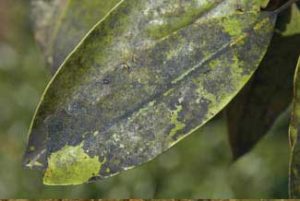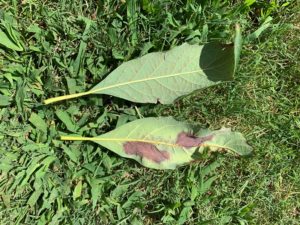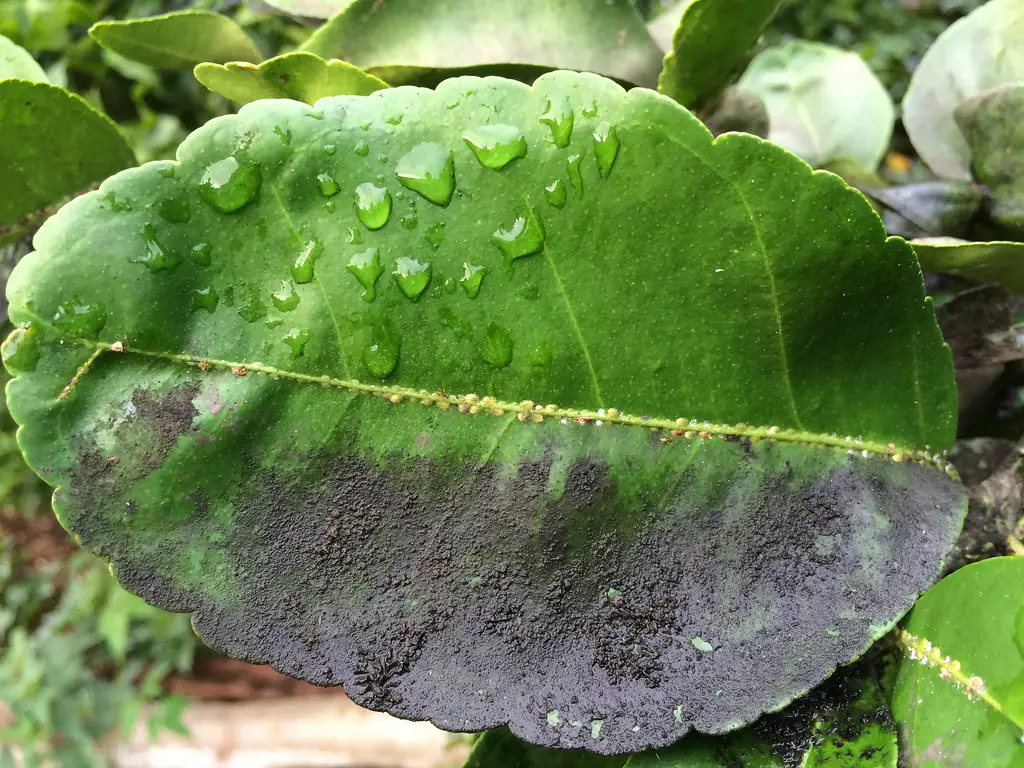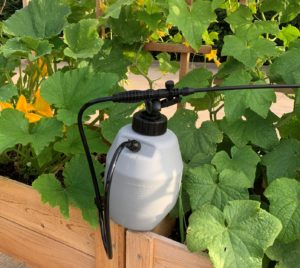If you have noticed a black or dark brown, powdery, soot-like mold covering primarily the upper surface of leaves and branches, chances are it’s sooty mold. This fungal organism grows on the honeydew secretions of aphids, scale, whiteflies, leafhoppers, mealybugs, and psyllids. When fungal spores land on the sweet, sticky substance, they reproduce threadlike mycelium, which creates a coating that looks like soot, hence the name sooty mold or black sooty mold. Sooty mold may be found on new plant growth because pests often prefer the tender tissue, but spores will soon spread to other parts of the plant wherever honeydew is present.
Damage
Black sooty mold is not pathogenic and should not be confused with black mildew, which is a plant parasite. Sooty mold only becomes problematic when it covers a plant to the degree that it hinders or prohibits photosynthesis, which can stunt plant growth and cause leaves to wilt and eventually die. The insects that feed on plant sap and secrete honeydew can, on the other hand, kill your plants. So it is best to address both problems.

This article contains affiliate links. If you make a purchase using one of these links, I will receive a very small commission at no additional cost to you, and it will help me maintain this website. Rest assured, I only recommend products I actually like!
How to Treat Sooty Mold
In order to effectively treat black sooty mold, you must eliminate the source of honeydew that the fungi uses as a food source. Determine which insect is producing honeydew and treat accordingly (I have articles for how to identify and eliminate aphids, leafhoppers, whiteflies, and mealybugs.)
Once the insects have been eliminated, you can remove the sooty mold by mixing one teaspoon of Castile soap with one gallon of warm water in a pump sprayer. Do a test spray on one leaf and wait 24-48 hours. If there is any damage to the leaf, dilute the mixture and retest. Thoroughly spray the sooty mold until well covered. Allow it to sit for several minutes to give the soap time to break down the organisms. Then gently wipe the mold off using a soft cloth. Rinse any remaining soapy water and mold off with a water hose.
After removing the sooty mold, spray the plant with neem oil, which is an effective antifungal agent. In addition, neem oil will help eliminate insects by disrupting their hormones, preventing them from developing through the various instars (stages), including the reproductive stage. The oil also acts as an antifeedant and can also disrupt the insects’ digestion.
To apply, choose a cold-pressed neem oil with the Azadirachtin, a naturally occurring compound that makes the neem oil more effective. Be sure to read the label as some manufacturers remove this vital ingredient. This is the neem oil I use. Mix 1 to 2 teaspoons of neem oil, 1/2 to 1 teaspoon of Castile soap, and 1 quart of lukewarm water in a sprayer. Shake and do a test spray on one leaf and wait 24-48 hours. If there is an adverse reaction, dilute the spray and retest. Apply the spray to all surfaces of the plant, including the underside of leaves. Repeat in five to seven days as needed.

If the sooty mold infection is severe, you may need to prune heavily infected leaves, etc. Be sure to wipe shears with a paper towel or cloth dipped in rubbing alcohol to remove any spores so as not to inadvertently transfer the spores to other plants.
Black sooty mold only grows on honeydew, so if the mold reappears after treatment, it means the insects that produce honeydew have returned. Retreat to eliminate insects.
How To Prevent
The best way to prevent fungal “infections” like sooty mold from getting a foothold in your garden is to grow healthy plants. This includes minimizing any stress a plant may experience from pest pressure, improper watering, or a lack of nutrients. Plants weakened by such stressors are more susceptible to disease.
Another way to help prevent sooty mold and other fungal diseases like powdery mildew and downy mildew is to improve air circulation by not overcrowding plants.
Black sooty mold is not only unsightly, it is generally a sign that sap-sucking insects are present. Thankfully, both conditions are easily treatable.
Thank you for reading this article! If you found it helpful, please consider sharing it with others via email and social media!



